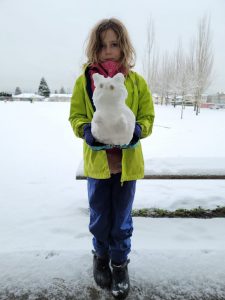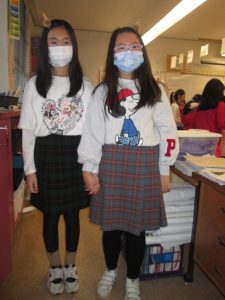Today I went to a field trip with my class. We were the only class that went on a field trip so we were lucky. Mrs. Ford wanted us to pair up with partners and she let us choose our partners so I chose Louis and we went to the school bus and Mrs. Ford told us our seat numbers. I’m pretty sure I was the only one that brought a water bottle to the field trip. I brought one because I thought I was gonna dehydrate. After recess we ate lunch. And after lunch we went on the school bus. It took us about 20 minutes to get there and I also found some familiar places as well as some new ones. Louis recognized more places than me. Then Kashvi drew a picture and she showed it to almost everyone on the school bus (the other people were too far to reach). The picture was kinda bad although a little better than what I could draw. And my ears were popping when I was on the school bus and I forgot to mention that the school bus was very big and shaky and we didn’t have any seat belts. Luckily I had the window seat so I had a less chance of falling off my seat. When we got there I realized I went there before with my parents and my brother. We also saw a statue about Simon Fraser (because this field trip was about the Fraser River). And we also saw the biggest tin soldier statue in the entire world. Then we waited for the Pollution to Solution people to come and then when they did they told us their names and then tested out knowledge about the Fraser River. We said it was 1375 km and we knew because we did research about it because it was our homework. Then we went into the building and put our jackets (and my water bottle) in a cubby. Then we went into a straight line and followed a person into the smallest theatre I have ever seen and the person gave us a PowerPoint presentation about the Fraser River, about the biodiversities and how it gets polluted and how we can solve the pollution and they also showed us a man in the 1980s I think and they said that that person saw a lot of pollution in the Fraser River and it upset him and he didn’t like it so he went for a swim. No not a swim in your average pool, he went for a swim in he Fraser River and I thought that was the most amazing thing that a person could do. While he swam in the River he also went to schools and other buildings and stuff and told the people inside that the Fraser River was really polluted and that those people should help. After he was done swimming in the Fraser River he rested and in 2000 or something he decided to go for a swim a second time in the Fraser River. The first time he went the chemicals in the river made his eyes sting so sometimes he couldn’t see where he was going, the second time it was much better and he also saw less garbage in the River. After the Presentation Mrs. Ford split the class in half because the presenters told her to do so and then one of the presenters took on half and we went to a place where we formed a circle and she asked us whether we knew the term Food Web. Then she asked us whether we knew the term Food Chain and we did and she said the Food Chain is basically the Food Chain and the Food Chain is where an animal eats another animal eats another animal or plant and so on. We’re at the top of the food chain. She said if you tried to draw the Food chain on a piece of paper, it would look more like a web so thats why she refers it to the term Food Web. And then she told us that if a plant was polluted and an insect stopped to rest and decided to take a bite off the plant, the insect would also get polluted, and if the insect got eaten by a bird, then the bird would get polluted and so on. Then she told us we were gonna play a game and that we were pollution and we were having a journey through different animals’ stomach. We were supposed to get a piece of paper and sharpie and we would start at a random animal or plant and we would write that animal or plant’s name on the piece of paper and roll a dice and whatever animal or plant that we get, we have to go to that station and write their name down. We had to repeat this process 12 times and I think I was the first person to finish it. There were a lot of things that didn’t make sense, like how could a mushroom eat a bear? But then when everyone was done (well ALMOST everyone since my partner, Louis didn’t finish) we got a mat to sit on and I got 2 mats and gave one to Louis and then we placed our mats in a circle and we sat down. The presenter was like * I bet your all wondering how a mushroom can eat a black bear so I’m gonna explain.* She said that the bear that had the pollution could die in the forest and decompose, but a mushroom could speed up the process of decomposing by eating bits of the bear. And then we gave our papers and sharpies back and we went to the other activity. When we got there there was a place where you put your face in it so you complete the picture of the human, but to me it just looked like a place where someone could chop your neck off. Then we went to this table where there were buttons that were covered in a black cloth. She said this was a map of the Fraser River and the little balls were the pollution. We got in a single file line, though it took us a little more than a few seconds, and we got to push one button for two seconds, and in those two seconds little balls of pollution would erupt out of the holes and they would fall down into the Fraser River. After we were done that, we went into the tiny theatre room and we went into a circle and the presenter said we were gonna play a game that involved out knowledge of objects that pollute or help the environment. She dumped out two bins of different objects and we each took turns taking a random objects from the pile and the rest of us were using our thumbs to say whether it was pollution or solution. There were things like plastic cups (no one picked that one) and plastic bags ( no one picked that to ) and a school bus. There were a lot more objects, but my hand feels too tired to type anymore. Then the other half of the class came and we went to watch a short movie about a young kid doing a science experiment. When he was done ( I think he was trying to make slime or something) he didn’t know what to do with it ( but then again why would a little kid not play with slime?) so he decided to dump it into the sink, but he changed his mind and decided to take a walk around his neighbourhood and dumped the slime in a small river instead and watched it flow away and he left and went back home. The slime floated around in t river and eventually went on the shore of a beach and it evaporated slowly and it was obviously edited, because slime can’t evaporate that fast ( I think ). And then the slime went into the clouds and it started snowing and the slime was in the snow and it looked weird and disgusting at the same time, and then the slime started dripping into another tiny river, until it formed into the slime again and it floated all the way into a water dam and it went into a hose and then we saw the boy again who was getting ready to go for a swim ( no not in your average Fraser River) in his kiddie pool and the water stopped working and he checked it and then the hose threw up his science experiment and it appeared right in front of him. I thought that was really funny and I bet that the boy was thinking *What were the chances?*. Then after that it was time to go so we went in pairs again with our partners and then Jayden wanted to sit with me so I sad yes and we sat in row 2 and Louis sat in row 3 so we could all chat with each other. Jayden said he biked from Marlborough to the Fraser River, and he said it took him about 40 minutes so he knew all the directions, but this was before Covid so he might have forgotten some of the directions. And as I already told you the bus was really shaky and bumpy and we had no seat belts, so I nearly fell off because this time I didn’t have the window seat. But thankfully Jayden caught me before I completely fell off. When the bus ride was over, I got back with my partner, Louis and Jayden got back his, Daren. And that was my field trip. And this is the longest blog post I’ve ever wrote. 1642 words can you believe that?!?!?!?!??!?!?!?!??!?!?!??!?!?!?!?!?!???????????????
From Pollution to Solution workshop


